For the first-time dog owner and dog owners in general, knowing what foods to keep away from your dog is essential. Some foods are poisonous and some are risky – avoid them at all costs and be diligent if utilising and storing these foods in the kitchen/pantry and around the home. Be certain if giving any of these ‘no no’ foods for dogs to children; ensure it is not accidentally dropped on the floor or allowed easy dog access. It’s commonly said that prevention is always better than the cure. Ensure not to leave any of these toxic or dangerous foods where your pet can get to them: in the trash (especially bones), fruit trees dropping produce on the ground (such as fruit pits, nuts or seeds), the compost heap, or the veggie patch (tomato, rhubarb and onion plants).
I felt this was an important topic to research because we have 3 pet dogs here at SBL and I wanted a thorough investigation on what our hounds could and couldn’t eat. So here goes…
Oh, and of course, if you suspect your dog has eaten any of the foods on this list, it’s best to contact a trusted vet for immediate assistance.
1. Chocolate, Coffee and Tea, Soda and Energy Drinks

Chocolate contains caffeine and a bitter-tasting stimulant called theobromine (which is also chemically similar to caffeine). Both are stimulants to the dog’s nervous system. Dogs metabolise these stimulants much slower than a human does.
They can wreak havoc in the dog’s system causing vomiting, diarrhoea, restlessness, hyperactivity, seizures, and even coma. Severity of symptoms depends on how much chocolate the dog has eaten and the size of the dog.
Some chocolates are more toxic than others. Dry cocoa powder contains the most amount of theobromine, baking chocolate next, then semi-sweet and sweet dark, and ordinary milk chocolate the least. White chocolate has a very small amount of theobromine. 1
You can use this handy chocolate toxicity calculator for further information or if you suspect your dog has eaten chocolate. Contact your trusted vet if there is a cause for concern.
(Calculator http://www.askavetquestion.com/chocolate_toxicity.php)
Coffee, tea, sodas (such as Cola) and energy drinks also contain caffeine. A high intake can cause increased heart rate and hyperactivity, vomiting, loss of muscle control, tremors/seizures and damage to internal organs. To put things in perspective, for these severe reactions (or death) to occur pets would have to drink 17 cups of coffee (17 tsps of dried coffee) or 10 cups of espresso to get very sick. Of course, the size and health of the dog has to be taken into consideration. Obviously, the smaller the dog, or any health conditions, the less of the substance is needed to cause toxicity. So a few laps of coffee here or there taken in by your pet, from your coffee mug for example, shouldn’t create any problems. Other foods and beverages, such as caffeine energy drinks and chocolate bars, won’t be as forgiving because of their higher caffeine and theobromine content. 2
Ensure that these foods and drinks are kept out of reach of pets. Lock away sweets and candy so there is no chance of ingestion.
Molly, our small moodle, likes the taste of coffee and milk. She can be sneaky and will take up the opportunity to drink up the remaining contents from our mugs! She has shown no signs of discomfort, however.
2. Foods That Pose a Possible Choking Hazard: Small and Pointy Cooked Bones, Corn and Avocado Pits

Dogs love to chew on bones. Chicken, fish and beef bones, when cooked, are a potential danger to the dog. These bones, when cooked, are brittle and will usually come apart into splinter-like shards. If a dog ingests them, these shards can get caught in the throat, teeth and digestive tract – they can cause serious internal injury. 3
It is also stated that smaller raw bones may also pose a risk of internal injury.So which bones are best to feed your pets? It’s recommended to feed raw bones that are as large as the dog’s head to be on the safe side, and promptly discard them after a few hours to prevent food-borne pathogens like salmonella . 77
Personally, we steer clear of giving dogs both raw and cooked bones that are small and pointy. If giving them a raw bone, we ensure that the piece of bone is the right size for the dog: i.e. larger than what it can fit into its mouth, to eliminate any choking hazards.
There is controversy as to whether corn in general is healthy for dogs to consume, especially on a continual basis. It is said by some that corn shouldn’t be fed to dogs at all even if it’s processed, cooked and said to be more easily digestible (commonly found in commercial dog food). 4,5
Corn is not considered to be toxic, but should be fed very minimally as it may cause digestive upset. Corn on the cob and avocado pits are possible hazards because they can accidentally be swallowed and can cause major problems: most commonly intestinal obstruction. Avoid at all costs. 5, 6
We rarely feed our hounds corn and we try to prepare home-made meals as much as possible.
3. Nuts
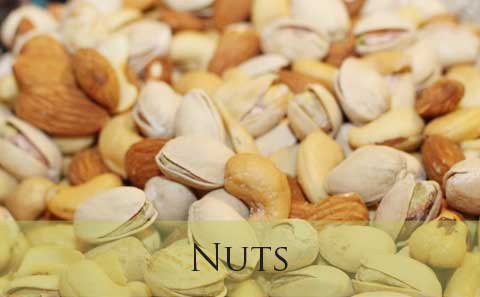
Although there are sources stating that some nuts are okay for dogs, others say that most types of nuts are toxic to dogs. Larger dogs can probably get away with eating a few nuts here or there, but smaller dogs are at a much higher risk of getting sick. I like to be on the safe side when it comes to feeding my dogs foods that are in controversy. I prefer to keep my pets away from all nuts, including peanuts.
Sources state that nuts such as almonds, walnuts, hazelnuts, pistachios, brazil nuts and pecans are poisonous. Macadamia nuts, too. Take care if eating them around the dog or giving to others as they can accidentally be dropped on the floor for the dog to pick up. They contain an aflatoxin which is derived from a mold called Aspergillus. Humans can handle this alfatoxin, but dogs can’t.
It is stated that dogs can get very ill if they eat nuts, causing gastroenteritis (illness causing vomiting and diarrhoea), lethargy, acute liver failure, blood tinged vomit and stools, orange coloured urine and jaundice.
Nuts are also high in phosphorous which can lead to bladder stones. Symptoms of this include trouble urinating, bloody urine and constant dribbling.
Severity of symptoms depends on how many nuts have been consumed and the size of the dog. If the intake was only small, symptoms should pass within a few days.
Macadamia nuts are apparently not as poisonous as other nuts but can still make the dog very sick. They can cause immobility, weakness, joint pain, abdominal pain, etc. 7
I have seen extreme weakness and lethargy first hand after two of my small dogs accidentally consumed a few almonds and macadamias.
I suspected our dog Molly had ingested a few macadamia nuts when we first got her. She couldn’t walk properly and looked weak. We made sure she had access to fresh water whilst she was recovering. After a few hours went by, she fully recovered.
Another time our small dog, Stella, ingested a couple of almonds that were dropped on the floor. Being a small dog, she went through extreme weakness and needed care for at least 24 hours until she eventually recovered.
If in doubt, always seek the advice of a professional.
Shelled sunflower seeds without salt and pepitas (pumpkin seeds) are beneficial for dogs. Raw pumpkin seeds can help cure parasites in dogs and act as a natural laxative. 8, 9, 10
4. Fruit Pits
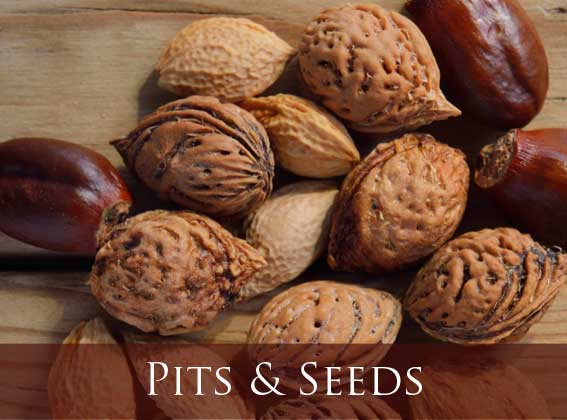
Avoid apple, cherry, peach, nectarine, plum and mango pits, which all contain certain levels of cyanide.
Not only should the pits be avoided, but also keep the dog away from leaves and foliage associated with peach, cherry and plum trees in particular. If you have any of these fruit trees on the property, it’s best to barricade the area so that the dog cannot get access to the tree or any falling fruit.
Persimmon seeds are not poisonous but can cause inflammation of the small intestine and blockages. As usual, smaller dogs are at a higher risk of illness. 11
Fruit pits are also a choking hazard and an intestinal obstruction hazard.
A dog’s system cannot eliminate cyanide, so the danger is that it has a toxic build up. Dogs may develop a range of symptoms which can cause kidney and liver damage. There are either chronic or acute symptoms, acute being the easiest to diagnose because of immediate symptoms. Chronic injuries can occur over a longer period of time if the dog is continually eating pits, leaves or stems. Other symptoms include breathing problems, lethargy, shivering, vomiting, diarrhoea, dehydration and abdominal pain, to name just a few. 12
5. Mustard Seeds
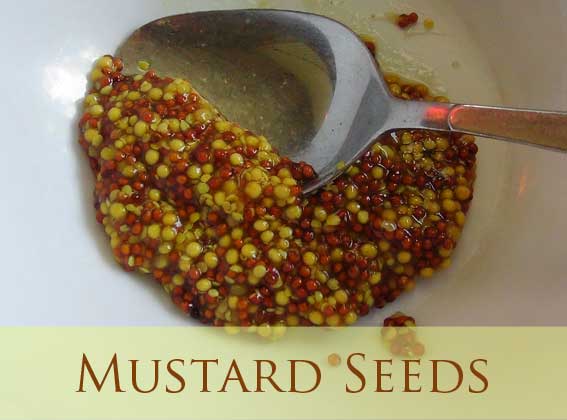
Some say mustard seeds are toxic, others (including a vet with over 30 years’ experience) say that mustard seeds in all its forms (Dijon, wholegrain, German style mustard, etc.) are not ‘toxic’ for dogs; however, do and can induce heavy vomiting and cause gastric upset. 13 Did you know that sometimes (under medical care) mustard powder and condiment mustard is used to intentionally induce vomiting if a dog, for example, has eaten something poisonous? 14 Prolonged vomiting, however, can cause dehydration and digestive issues. 15 A trusted vet should be contacted if symptoms such as these persist.
6. Rhubarb, Green and Raw Potatoes, Unripe Tomatoes and Other Veggies In the Nightshade Family
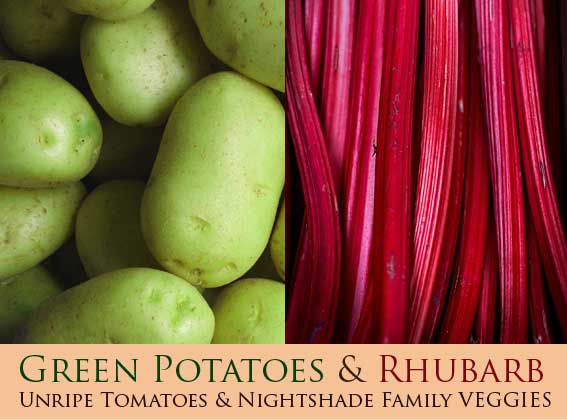
Both these vegetables contain oxalates: potatoes in their raw form, and rhubarb in general.
Keep dogs away from leaves and stems of both plants if growing them in the garden. Green potatoes are said to be toxic both on the outside peel and on the inside, too. A green potato will have certain solanine alkaloids that are poisonous to dogs. 16
Cooked potatoes fed to the dog in moderation are safe for them to eat.
Another common garden plant to keep away from dogs is tomato leaves and stems. They have a similar alkaloid to solanine called tomatine. Unripe tomatoes still contain tomatine but in much less amount than the leaves and stems, so symptoms will be milder. As the tomato ripens, the tomatine is processed until only miniscule amounts of tomatine remain, therefore becoming safe enough for your dog to eat.
Other vegetables in the nightshade (Solanaceae) family of plants, such as eggplant, chilli, peppers (capsicums), tomatillos, should be kept to a minimum. Their leaves and foliage also contain toxic alkaloids, so make sure your dog stays out of the veggie garden.
The oxalates in raw and green potatoes and rhubarb can trigger problems in the digestive tract, nervous system (such as tremors and seizures), kidneys and can cause heart arrhythmias.
Tomatine poisoning includes symptoms such as digestive problems, difficulty breathing, vomiting, diarrhoea and constipation, lethargy and even tremors or seizures. Coma and death could result. 17-19
7. Grapes and Raisins
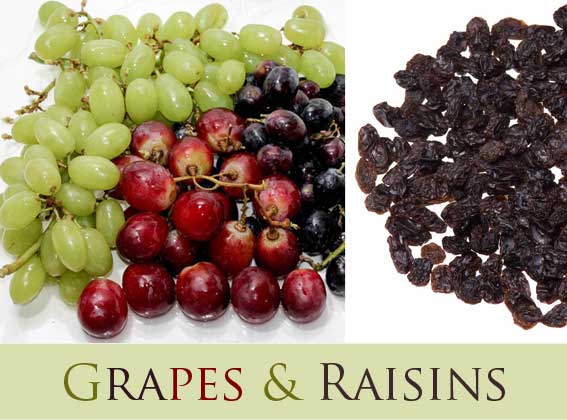
Both fresh grapes and dried grapes (raisins, currants and sultanas) are poisonous for dogs. This includes any variety of grapes, seedless or not, green or red. Any food containing grapes such as grape juice is dangerous, too. If a grape vine is present in the garden or around the home, ensure the dog can’t get to any grapes on the vine or falling off the vine.
It’s unknown as to why grapes and dried grapes cause problems (a mycotoxin/fungal poison is suspected to be involved) 20 such as severe or acute kidney failure and anuria (lack of urine production) in dogs. Ingesting a small amount can result in problems. 21
8. Allium Species – Onions, Leeks, Spring Onions, Chives, Shallots, Scallions
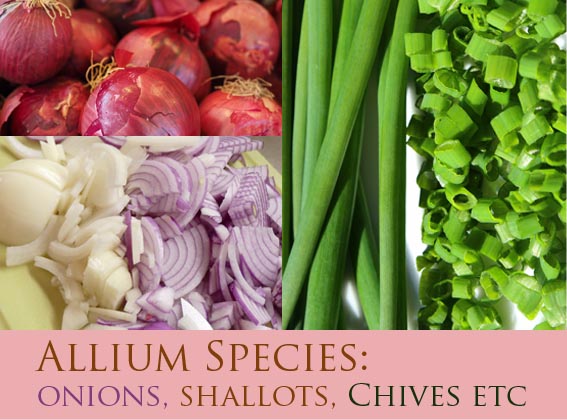
Onions, leeks and spring onions (raw, cooked or powdered) are not good for dogs because they destroy red blood cells (erythrocytes) causing anaemia; specifically a form of Hemolytic anaemia called Heinz body anaemia, which basically means a low red blood count.
Organosulfur compounds are found in the allium species; it is what gives them their strong odour and flavour. Thiosulfate is another substance present which is harmful for dogs. Both of these compounds and substances contribute to ‘toxicosis’ (pathological condition caused by the action of a poison or toxin) because they don’t have the enzyme to digest them.
It is uncertain as to how much onion will cause problems, and symptoms may not show themselves instantly. One source states that it has been found that toxicosis has been noted in animals that ingest more than 0.5% of their body weight in onions at one time, or 15-30 grams per kilogram of the dog’s weight. 22 So long as the consumption is small, dogs can recover on their own because the bone marrow will generate new blood cells, although small and repeated amounts over time can eventually affect the dog’s health and vitality. Where there has been a large amount of consumption of these foods in proportion to the dog’s weight (more than 15-30g per kg of the dog’s weight), symptoms such as diarrhoea, vomiting and lethargy, liver damage, trouble breathing and pale gums may also occur. In severe cases, a blood transfusion is required. 23-25
9. Too Much Garlic?
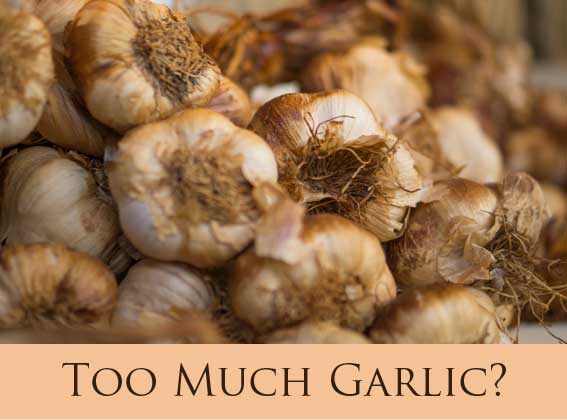
Garlic is stated by most sources to be toxic, like onion. Apparently, it’s hard to find clinical evidence that conclusively proves garlic in low doses causes any significant negative reactions. In some studies, a lower red blood cell count was found in canines tested, but was due to large quantities being given. Studies did not use raw garlic (usually an extract, administered in appropriate doses).
Just like consuming too much salt, selenium, boron or even water, for example, can be harmful, and this would most probably be true for garlic in high amounts, too.
On the contrary, it is said by doctors that garlic can have beneficial medicinal effects, as long as taken under certain rules and precautions. Some benefits include intake of vitamins A, B vitamins, C, calcium and magnesium, to name a few. It is stated to be beneficial for detoxifying and preventing certain diseases, including cancer, and even for preventing ticks, fleas and mosquitos.
Which dogs shouldn’t be fed garlic?
- The dog is in good digestive health
- On any prescriptive medication
- Puppies before 6-8 weeks of age (because they don’t produce new blood cells until after this age)
- Any dog with auto-immune diseases (such as lupus)
- Dogs with anaemia
- Specific Japanese breeds Akitas and Shiba Inus should avoid garlic altogether.
- Any dogs that will be going into surgery should avoid garlic at least 2 weeks beforehand.
- Pregnant or nursing bitches should also temporarily avoid garlic because it can change the taste of the milk and may contribute to colic. 26
Organic, raw and freshly cut or minced garlic is best – no other forms of garlic should be used. Only raw garlic contains allicin and alliinase, two enzymes responsible for the active medicinal properties present. The Chinese imported garlic may have artificial toxins that you won’t want your dog to ingest – hence why organic is best. Letting it sit for 10-15 minutes is important before giving to the dog.
Researching a bit more about garlic, I have found that when one slices, chops, minces or presses garlic before cooking (the finer the better), then let’s it sit for 10 minutes, the two enzymes allin and alliinase combine and form a new compound called alliicin. Alliicin is what gives garlic its anti-cancer activity. If the garlic is cooked without giving it time to sit, the alliicin won’t be produced. 27, 28
Dr. Pitcairn, the author of The Complete Guide to Natural Health for Dogs and Cats, gives us these specific dosages:
- 10 to 15 pounds (4.5kg to 7kg) – half a clove
- 20 to 40 pounds (9kg to 18kg) – 1 clove
- 45 to 70 pounds (20kg to 32kg) – 2 cloves
- 75 to 90 pounds (34kg to 40kg) – 2 and a half cloves
- 100 (45kg) pounds and over – 3 cloves
Various sources state that you can either use garlic daily mixed with food, or feed them 3-4 times per week. It is suggested that sprouted garlic has more medicinal properties than non-sprouted garlic. 29, 30
If feeding daily it is probably a good idea to skip a few days here and there, or take a whole week off from feeding them any garlic. Others use garlic seasonally, before flea season hits or for prevention of colds and flu in the winter time. It really depends.
If using for tick and flea treatment, it is recommended to take daily for two weeks, then twice a week for maintenance. 31, 32
Some brands of mixed meat, veggies and rice pet rolls that are readily available at the supermarket here in Australia contain garlic oil as an ingredient. This is something to look out for.
Only give a dog garlic if you feel confident in giving it to them, otherwise don’t.
We have been feeding our dogs raw garlic for a few months now and so far it has been difficult to tell whether it’s been working to eliminate/prevent fleas.
10. Wild Mushrooms
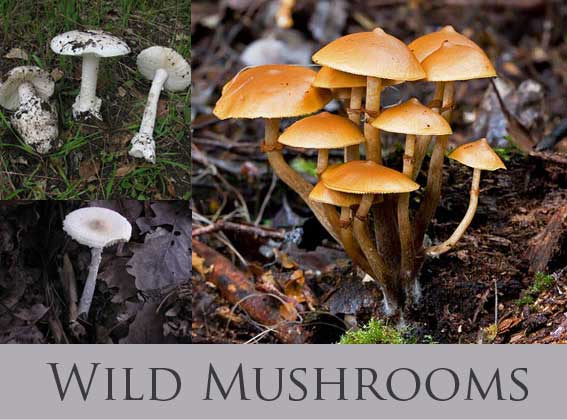
Mushrooms that are commonly found at the supermarket are okay for dogs. Sources state that a small amount of mushrooms can be beneficial for the dog – as long as there are no food allergies associated with them (which is unlikely), or digestive upsets. 33
It’s the wild mushrooms that are the danger point (even though only 1% of wild mushrooms are said to be poisonous for both humans and dogs). If ingested, these types of mushrooms can cause abdominal/digestive issues, organ damage and can ultimately lead to death. To be on the safe side, it is always best to keep dogs away from all mushrooms growing in the wild.
Here are some of the most poisonous liver-toxic mushrooms that exist:
1: Death Cap Mushroom (Amanita phalloides)
They are usually greenish in colour but cap colour can vary, some look white. They have a white stripe and gills. They appear in summer and autumn.
Ingesting half of one of these mushrooms is enough to kill an adult human! 34
2: Angel of Death (Amanita ocreata)
These toxic mushrooms are equally as poisonous as the Death Cap Mushroom. They are found in North America, commonly found to grow around oak trees. 35

https://en.wikipedia.org/wiki/Amanita_ocreata#/media/File:Amanita_ocreata_79782.jpg
3. Lepiota (False Parasol)
There are around 400 species of Lepiota, many are poisonous, some are lethal. They have whitish spores, scaly white/cream caps approx 10cm in size with a slender stem. They occur in conifer woodlands, common in northern Europe, and they prefer a warm climate. 36
4. Galerina
With over 300 species found all over the world, commonly found growing on rotting wood or mossy areas. Although they look similar to another variety of hallucinogenic mushrooms (called Psilocybe that are sought after by mushroom hunters) Galerina is deadly if ingested. 37

https://en.wikipedia.org/wiki/Galerina
JJ Harrison (jjharrison89@facebook.com) – Own work
There are many other varieties, such as toadstool mushrooms (red cap with white spots), hallucinogenic mushrooms, mushrooms containing muscarinic agents and less toxic varieties of false morel mushrooms which are also harmful for dogs. Read more about them here: https://www.petmd.com/dog/slideshows/6-poisonous-mushrooms-are-toxic-dogs.
We commonly have mushrooms sprouting spontaneously in our fields and growing in between the grass. Our dogs don’t generally eat them, but this may not be true across the board.
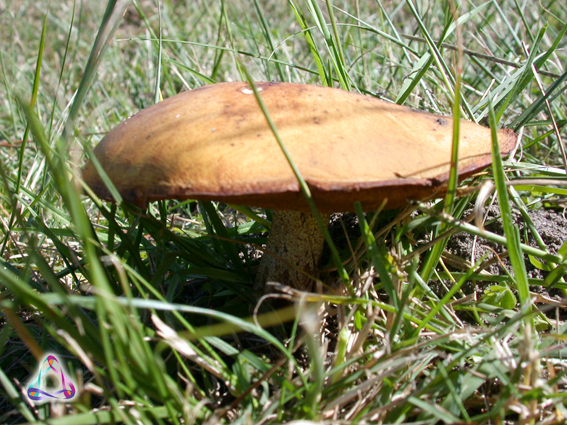
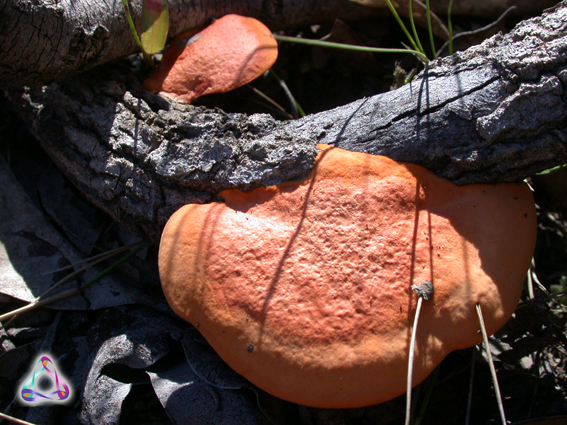
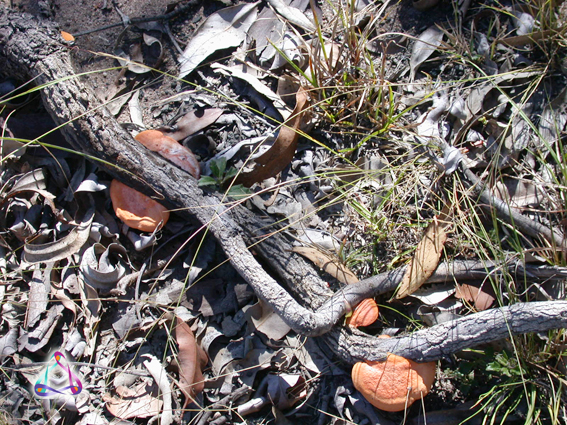
If your dog looks like it might try to eat a wild mushroom, it may be wise to remove the mushrooms altogether. Keep a watchful eye at all times and/or walk them on a leash.
11. Avocados

There seems to be controversy and confusion surrounding avocados, with many sources stating it is toxic to dogs. Other sources confidently state that there is no conclusive evidence that has proven it is harmful. Veterinary doctors even state that the fruit of the avocado is safe and can have health benefits if used supplementarily. This doesn’t apply to other animals; such as birds, horses, rabbits and goats however, who are sensitive to ‘persin’. Persin is a substance found in the pit, skin, leaves and bark of the avocado tree as well as unripe fruit. The main concern with avocados is the pit of the avocado which, if swallowed, can cause throat, stomach and intestinal blockages. It is crucial to discard with certainty so there is absolutely no chance of access to the pit (and other parts that are normally discarded).
Did you know that commercial dog food includes avocado as part of their recipe? One particular brand states on their site that with over 30 years of their product on the market, there has been no negative reactions (to dogs and cats) to the fruit and oil which is utilised. 38, 39
Avocados are a natural super food providing: vitamins A, C and E, B6, quality proteins, omega fatty acids, folate, potassium and antioxidants for a healthy immune system. It is said that if fed in small amounts, avocados can actually support health by giving pets a shiny coat. This is because vitamin E and omega fatty acids are good for hair. Also, the combination of vitamin E with the vitamin A found in avocados will benefit the dog’s skin and improve and maintain healthy eyesight. 40 Veterinary doctors in the US including Dr. Steve Barghusen, Dr. Susan Wynn and Dr. Oscar E. Chavez, to name a few, give avocados the ok when it comes to feeding them to dogs. Because of the high fat content, they caution giving too much as it may lead to health problems, such as pancreatitis. 41 Dr Wynn says that it’s wise to use avocado as a supplement, like a treat, rather than part of the pet’s meal. Dr Chavez suggests to feed only common varieties and avoid Guatemalan/Mexican hybrids (such as Fuerte, Bacon, and Zutano entirely), just to be on the safe side. 42, 43
12. Alcohol, Beer and Hops

Alcohol
Alcohol, from many sources is stated to be dangerous for dogs, whether ingested or applied topically. Alcohol can be found in different sources; this also includes some commercial products such as flea sprays and dental care sprays and also medications such as cough syrup. Also watch for sweets or cakes that may be flavoured with alcohol, too. 44
Usually, dogs don’t like the taste of alcohol and will generally stay away from it because of its strong odour and taste, but this may not be true across the board. Dogs can’t process alcohol like we can, especially because of their size in comparison to humans. Alcohol poisoning in dogs is called ‘ethanol toxicosis’. 45 The more alcohol a dog ingests, the worse the symptoms can get. Dogs have a much lower tolerance than we do when it comes to alcohol, so what may be considered small amounts for humans would be too large an amount for dogs. Some liqueurs contain 40% alcohol, so even a small shot is enough to make a dog very ill. The smaller the dog, the more at risk they are of being poisoned. Consuming alcohol will affect their nervous system and they will begin to look weak, disorientated and confused. If consumption is high, signs of severe poisoning could include bloating, vomiting and loss of bladder control. This can ultimately lead to heart failure and comas. 62
Beer
Beer contains the smallest amount of alcohol (3 to 5%), wine is next (9 to 12%), and hard liquor contains the most (40 to 90%). Wine, which is made from grapes, should be kept well away from dogs because grapes are also a toxic food for them. Any other alcoholic drink containing nuts, milk or sweeteners can carry with it more than one poisoning issue for dogs.
Hops
Although beer has only a small amount of alcohol compared to other alcoholic beverages, it is toxic for another added reason: hops. Hops are cone-like flowers that have a bitter flavour when they are dried. They are traditionally used in the beer making process to flavour beer but can also be found in other products such as herbal teas and herbal creams. Either in its raw state or dried state it is toxic for dogs, and it is stated that only a small amount of ingestion is needed to cause poisoning. Poisoning symptoms of hops include heightened body temperatures, heavy breathing and restlessness. Extra large dosage intake includes abdominal pain, vomiting, blood clotting, seizures and even death. It’s best to keep hops of any kind and from any source away from canines. This also includes the compost heap. 46, 61
13. Bakers Yeast and Raw Dough
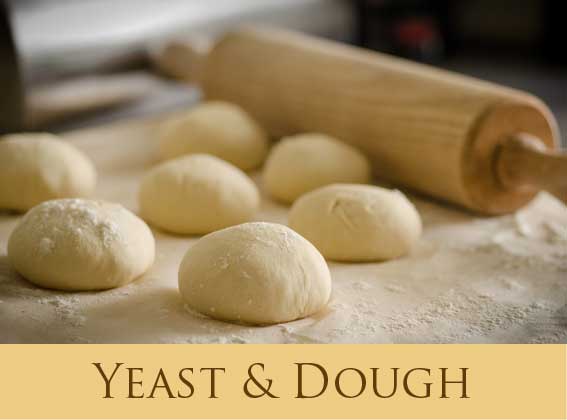
Raw bread dough which is activated by yeast is toxic for dogs, but not bread. The cooked product (as long as it contains no onions or raisins) is okay to consume in small amounts because the yeast is killed at high temperatures (55-60°C).
Not all yeasts are the same, and yeast used in bread-making is active and can be toxic for dogs. The toxicity lies both in the inactivated raw yeast (in powdered form and fresh) and activated yeast within bread dough. The fermentation of the yeast is what causes the dough to rise. Sugar is converted into carbon dioxide gas (CO2) and ethyl alcohol via the yeast cells using a range of enzymes. Whilst this happens, ethanol or alcohol is produced. 47, 48 Apparently, it can cause the dog’s stomach to bloat and potentially twist; this is called Gastric Dilatation Volvulus (GDV) and is considered a medical emergency. Other symptomsof baking yeast poisoning in all formsinclude drooling or over-panting, anxious and restless behaviour, vomiting and shallow breathing. Also, the creation of alcohol may cause the dog to develop ethanol toxicosis or alcohol poisoning. 49, 50, 63, 64
Brewers and Nutritional Yeast
Brewer’s and nutritional yeast are both inactive so are considered safe, even healthy for dogs. This source https://www.cuteness.com/article/brewer-yeast-dogs tells us that brewer’s yeast can be beneficial for dogs as long as there are no allergens relating to it and when taken in the correct doses (allergic symptoms may include itchy skin and rashes). Brewer’s yeast is rich in B vitamins, chromium and selenium. It can also aid in repelling ticks and fleas. If too much is taken, though, stomach upsets can result. So as long as dosage is kept at ½ tsp per 10 pounds of body weight for powders (if taking pill form, dosage should be supplied by the manufacturer), and there are no allergies associated, it can be used as a natural supplement. 51, 52,53
Differences? Brewers yeast is more bitter-tasting than nutritional yeast. Nutritional yeast has a cheesy taste and is a good replacement in vegan dishes. Brewer’s yeast does not provide vitamin B-12, while nutritional yeast does not provide chromium. Both provide an array of B vitamins, with niacin, folic acid, zinc, selenium and thiamine. 54, 55 Dr. Pitcairn and Susan Hubble, authors of The Complete Guide to Natural Health for Dogs and Cats, recommended to feed nutritional yeast to pets. 56, 65
I have tried brewer’s, but have not given it to my dogs. Hmm, this may be a good natural solution to prevent ticks/fleas and boost their health, along with garlic and Diatomaceous Earth…
What about fermented foods, don’t they have alcoholic content?
There is controversy in regards to fermented foods. Some say it’s a healthy pro-biotic, whilst others say dogs should stay away from these foods because of the alcoholic content. 57
There are two main types of fermentation: alcoholic fermentation (alcoholic beverages), which produces a high percentage of alcohol, and lactic acid fermentation (dairy and vegetable products) which we find in fermented foods. With this method of fermentation, the alcoholic content is apparently very low in comparison to alcoholic fermentation, so these foods shouldn’t be a cause for concern (but if doubtful, then refrain from feeding it to your dog). 58, 59, 60
We have experimented with fermentation through the years and have found that most vegetable fermentation we tried has had little to no alcohol present, such as home-made sauerkraut. Making kefir drinks with cane sugar and molasses did have a slight fizz and alcoholic taste when ready. The more sugar the food contained, the more likelihood of alcohol produced.
As they say, when there is an excess of alcohol you should be able to smell it, see tiny bubbles and taste fizz (carbon dioxide) within its contents. 56
It is commonly encouraged that pet owners feed their dogs fermented foods such as apple cider vinegar, pickled vegetables, Sauerkraut, kimchi and kefir, to name a few. This is why several sources state that these fermented foods are extremely beneficial for dogs as a pro-biotic (for gut health), although I haven’t included fermented foods in their diet so I can’t comment on this.
14. Xylitol (Artificial Sweeteners), Cane Sugar and Salt
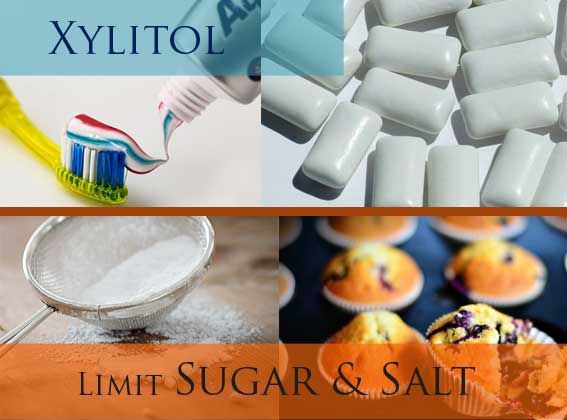
Xylitol
Xylitol is a sugar alcohol that is used as an artificial sweetener in manufactured products. Production begins with extraction from hardwood and corncobs, producing xylan, an aldose sugar (non-digestible, according to Dr. Axe). From there, xylan is converted to xylitol, a primary alcohol, via hydrogenation. 78
There is controversy surrounding whether xylitol is safe for consumption. It is labelled by many as being derived from ‘natural’ sources, but Dr. Axe argues the point in his articles. He lists Xylitol as an artificial sweetener that can ‘severely harm our health’ and is included at number 5 within his top 5 Worst Artificial Sweeteners (https://draxe.com/artificial-sweeteners/list).
Xylitol is known to be an especially dangerous substance for dogs to consume and is also toxic for humans, according to various sources. Xylitol can be found in many foods on the market, even some peanut butter brands! Other sources include sugar free gum, candy, breath mints, chewable vitamins, baked goods, mouthwash and toothpaste. 66, 67
One piece of unchewed gum made with xylitol is a potentially toxic amount for a 10 pound dog. All other types of gum (including artificially sweetened with other types) pose a risk of internal blockages, especially with smaller dogs. 69
With dogs specifically, the danger with xylitol, is when their pancreas mistakes it for real sugar releasing a surge of insulin. This surge causes a dangerous drop of blood sugar levels (hypoglycemia) and if untreated, can be life threatening, potentially leading to symptoms of shock. 68
For many years, we have diligently made an effort to stay away from all artificial sweeteners available on the market, both for ourselves and our dogs.
Cane Sugar
Not all sugars are the same and for similar reasons as to why sugar is bad for humans, it is the same for dogs. Cane sugar causes energy surges in the body – a rise in insulin. Insulin has many effects on hormones which regulate bodily functions such as fat storage, the immune system and energy levels. These abnormal changes within the body created by consuming simple sugars (such as cane sugar) can lead to health problems down the track. Some of these problems include obesity, diabetes and dental cavities. 70 Keep a look out for store bought treats that are sweetened with cane sugar.
Salt
Salt is needed for a dog’s healthy metabolism. Usually though, dogs get enough salt within their foods, so it’s unnecessary to add any to their diets. Eating a little bit of salt isn’t too harmful but will make them dehydrated and thirsty, so it’s best to keep all salty snacks away from them. If it so happens that a dog consumes lots of salt, e.g. soy sauce, home-made play dough or even lapping up seawater, then toxicity symptoms may occur. Hot dogs and other processed meats may contain nitrites and a high amount of sodium, so it’s best to keep these foods away from dogs. Salt toxicity is called hypernatremia. The first sign that indicates the dog has consumed too much salt will be that the dog will be very thirsty and will seek fresh water to drink. Fresh water is the first thing that is needed if a dog has consumed too much salt, as it dilutes the salt in the blood and eliminates it through urination. Other symptoms of toxicity include: stomach upset and nausea, weakness, vomiting and diarrhoea, increased heart-rate and fever. 71
15. Milk and Dairy Products
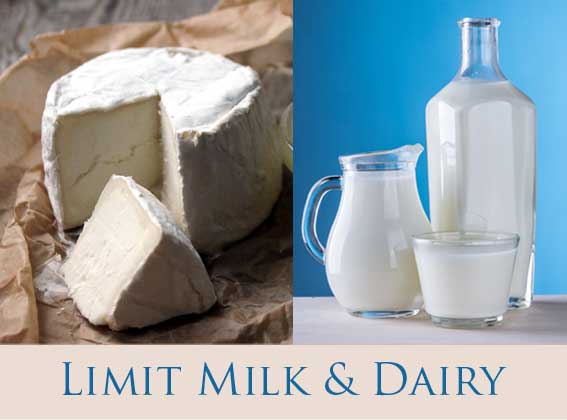
Milk and dairy products are not considered ‘toxic’, but rather not healthy if consumed in large amounts. The only dairy products that may pose a threat are mouldy cheeses, so it’s best to avoid feeding these to dogs because of a toxin called ‘roquefortine’, especially present when the cheese is over-ripe or mouldy. Symptoms of ingestion can be similar to lactose intolerance symptoms (abdominal pain, vomiting and diarrhoea, spasms, lethargy and potential neurological signs). The dog should be monitored closely and a qualified and trusted vet contacted if poisoning is suspected and symptoms occur. 72
Also, if a pet happens to be ‘lactose intolerant’, dairy may cause unwanted symptoms. Lactose intolerance, which is common in humans and can also be in pets, means that the enzyme ‘lactase’, which is needed to properly assimilate dairy, is not reliable. Lactose is a type of sugar with two chemically linked sugar molecules. This is where lactase comes in – to separate these molecules so the body is able to assimilate and easily digest dairy.
Symptoms of lactose intolerance include gas, bloating, loose stools, abdominal pain, vomiting and diarrhoea. Lactose intolerance is different to a food allergy, which is supposed to trigger an immune system response. Food intolerances are adverse reactions that are caused by certain foods, but are not immune system related. Both can be confused with one another because unwanted symptoms, caused by suspect foods, can be very similar, but triggered by one of these two reasons. 73, 75, 76
It’s interesting to know that some dairy products have more lactase than others.
Dairy Products that have a low percentage of lactose are:
- Butter, (up to 1% lactose)
- Cheeses such as: Provolone, Gouda, Cheddar, Edam and Swiss, Brie and Camembert (up to 2.2% lactose)
Take a look here for a detailed chart of percentages: www.stevecarper.com/li/list_of_lactose_percentages.htm.
If feeding to your dog, ensure there are no onions, and avoid mouldy cheeses such as Roquefort, Gorgonzola, Stilton and others. 74
If your dog can handle dairy, then a little bit as a treat or reward is ok, especially if the dairy contains a lower percentage of lactose, such as butter or some cheeses. I give our dogs cheddar cheese every now and again and they love it. I also use a little bit of butter melted in their veggies and it makes their home cooked food even more delicious!
You may be interested about my personal investigation and application on food allergies (for humans) using an unconventional testing method: the BCFT test.
Conclusion
So, there we have it. The foods listed in this article were the ones I found to be the main culprits of food poisoning in dogs and also the foods with potential choking hazards. Researching for this article opened up my eyes to new and important information. I had no idea many of these seemingly innocent foods for humans could wind up lethal for our dogs.
I hope this helped you, too.
References:
- https://www.vets-now.com/pet-care-advice/dog-eaten-chocolate/
- https://vcahospitals.com/know-your-pet/caffeine-toxicity-in-pets
- http://www.dogingtonpost.com/give-dog-bone-but-make-sure-its-safe-first/
- https://www.quora.com/Is-it-safe-for-dogs-to-eat-corn-dogs
- https://www.dogfoodadvisor.com/dog-food-industry-exposed/dog-food-corn/
- https://www.akc.org/expert-advice/nutrition/natural-foods/can-dogs-eat-corn/
- http://www.dogheirs.com/toxic-fruits-vegetables-nuts-for-dogs/
- https://mom.me/pets/17928-what-human-foods-can-dogs-eat/item/can-dogs-eat-sunflower-seeds/
- http://www.thrivingcanine.com/pumpkin_seeds
- https://www.quora.com/What-are-the-consequences-for-dogs-that-eat-pumpkin-seeds
- https://www.mercurynews.com/2014/10/23/persimmon-loving-dog-at-risk/
- https://wagwalking.com/condition/peach-pits-poisoning
- https://www.justanswer.com/dog-health/7k3gv-mustard-seeds-toxic-dogs-dog-ate-when.html
- https://www.cuteness.com/blog/content/is-mustard-good-or-bad-for-dogs
- https://doghealthcoach.com/food/can-dogs-eat-mustard/
- http://www.dogheirs.com/toxic-fruits-vegetables-nuts-for-dogs/
- http://www.animalbehaviorcollege.com/blog/plants-poisonous-to-dogs-and-cats/
- (https://pets.thenest.com/tomato-leaves-dangerous-cats-dogs-5664.html)
- http://www.dogheirs.com/toxic-fruits-vegetables-nuts-for-dogs/
- https://en.wikipedia.org/wiki/Grape_and_raisin_toxicity_in_dogs
- http://www.petpoisonhelpline.com/pet-safety-tips/are-grapes-and-raisins-poisonous-to-dogs/
- http://veterinarymedicine.dvm360.com/toxicology-brief-allium-species-poisoning-dogs-and-cats
- https://wagwalking.com/condition/onions-poisoning
- http://www.dogsnaturallymagazine.com/garlic-for-dogs-poison-or-medicine/
- http://www.dogingtonpost.com/my-dog-ate-onion-what-now/
- http://www.petremedycharts.com/Learning%20Center/Introduction%20to%20Herbs/LH%20Garlic/Garlic_for_pets.html
- https://www.natural-dog-health-remedies.com/garlic-for-dogs.html
- http://www.whfoods.com/genpage.php?tname=george&dbid=136
- https://realfarmacy.com/garlic-toxic/
- https://www.natural-dog-health-remedies.com/garlic-for-dogs.html
- http://www.dogsnaturallymagazine.com/garlic-for-dogs-poison-or-medicine/
- https://www.natural-dog-health-remedies.com/garlic-for-dogs.html
- http://canigivemydog.com/mushrooms
- https://en.wikipedia.org/wiki/Amanita_phalloides
- https://en.wikipedia.org/wiki/Amanita_ocreata
- https://en.wikipedia.org/wiki/Lepiota
- https://en.wikipedia.org/wiki/Galerina
- https://www.avodermnatural.com/about/why-avocados
- https://iheartdogs.com/the-truth-about-avocados-are-they-bad-for-dogs/
- http://thesmartcanine.com/can-dogs-eat-avocado/
- http://www.pawculture.com/pet-wellness/nutrition/can-dogs-eat-avocado/
- http://www.avocadofactsfordogsandcats.com/dogs.html
- http://canigivemydog.com/avocado
- http://www.natural-wonder-pets.com/alcohol-in-dog-dental-sprays.html
- https://www.petmd.com/dog/conditions/neurological/c_dg_ethanol_toxicosis?page=show
- https://wagwalking.com/condition/hops-poisoning
- http://www.yobrew.co.uk/fermentation.php
- https://animalso.com/can-dogs-eat-bread/
- https://www.aspca.org/pet-care/animal-poison-control/people-foods-avoid-feeding-your-pets
- https://www.puppyleaks.com/dog-eats-yeast/
- https://www.livestrong.com/article/176197-what-is-the-difference-between-brewers-yeast-nutritional-yeast/
- https://www.livestrong.com/article/418496-what-is-the-difference-between-brewers-yeast-bakers-yeast/
- http://www.petguide.com/health/dog/natural-health-brewers-yeast-benefits-for-dogs/
- https://www.livestrong.com/article/176197-what-is-the-difference-between-brewers-yeast-nutritional-yeast/
- http://www.petguide.com/health/dog/natural-health-brewers-yeast-benefits-for-dogs/
- http://dogzenden.blogspot.com.au/2010/09/benefits-of-nutritional-yeast.html
- http://fermentacap.com/alcohol-in-your-lacto-fermented-foods/
- https://healthcare.utah.edu/healthfeed/postings/2015/07/070115_fermented.foods.php
- http://petfooddiva.com/fermented-foods-for-dogs-and-cats/
- http://www.dogsnaturallymagazine.com/fermented-foods-for-dogs/
- http://www.dogster.com/lifestyle/can-dogs-drink-beer-wine-alcohol-ethanol-hops-grapes-poisoning-toxicity
- https://wagwalking.com/condition/alcohol-poisoning
- https://animalso.com/can-dogs-eat-bread/
- https://www.petmd.com/dog/emergency/poisoning-toxicity/alcohol-risks-pets-beer-wine-and-liquor
- https://www.livestrong.com/article/471516-benefits-of-yeast-extract/
- https://draxe.com/xylitol-side-effects/
- http://thescienceexplorer.com/nature/fda-warns-popular-artificial-sweetener-can-kill-dogs
- http://thescienceexplorer.com/nature/fda-warns-popular-artificial-sweetener-can-kill-dogs
- https://pethelpful.com/dogs/Health-risks-of-dogs-ingesting-sugar-free-gum
- https://www.petmd.com/dog/slideshows/6-reasons-why-your-dog-shouldnt-have-sugar
- https://wagwalking.com/condition/salt-poisoning
- https://www.justanswer.com/dog-health/3rrk7-blue-cheese-toxic-dogs.html
- http://www.petwave.com/Dogs/Health/Lactose-Intolerance/Symptoms.aspx
- https://www.petcha.com/can-dogs-eat-cheese/
- https://www.dogfoodadvisor.com/dog-feeding-tips/dogs-milk-dairy-products/
- https://www.aspca.org/pet-care/animal-poison-control/people-foods-avoid-feeding-your-pets
Have you got any more foods that you could add to this list? Had any experiences with toxic foods and your dog? Share in the comments section below.
READ MORE about dog allergies here: A guide to seasonal allergies in dogs: betterpet.com – What you need to know about identifying and treating seasonal allergies in dogs.

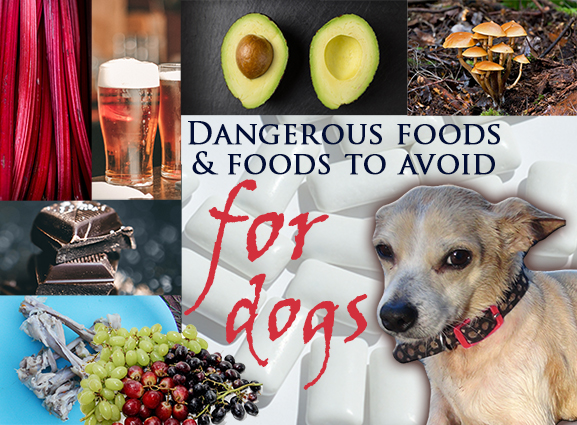


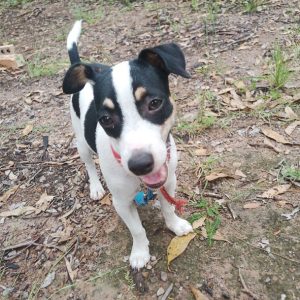
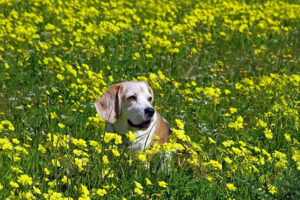

Amazing and informative blog thanks for amazing blog